-
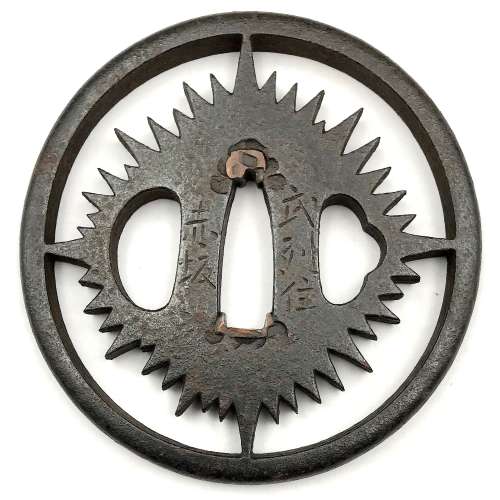 Iron tsuba of round form with slanting rays of light (shakoh) Christian motif (Jesuit’s IHS symbol) in openwork (sukashi). Traditional description of this kind of design is called “tokei”, or “clock gear”. Signed: On the face: Bushu ju Akasaka; On the back: Tadatoki Saku [Made by Tadatoki, resident of Bushu]. Probably, 4th generation of Akasaka School master Tadatoki (忠時), who died in 1746. Akasaka School. Edo period, first half of the 18th century. Size: 79.8 x 78.5 x 6.5 mm
Iron tsuba of round form with slanting rays of light (shakoh) Christian motif (Jesuit’s IHS symbol) in openwork (sukashi). Traditional description of this kind of design is called “tokei”, or “clock gear”. Signed: On the face: Bushu ju Akasaka; On the back: Tadatoki Saku [Made by Tadatoki, resident of Bushu]. Probably, 4th generation of Akasaka School master Tadatoki (忠時), who died in 1746. Akasaka School. Edo period, first half of the 18th century. Size: 79.8 x 78.5 x 6.5 mm -
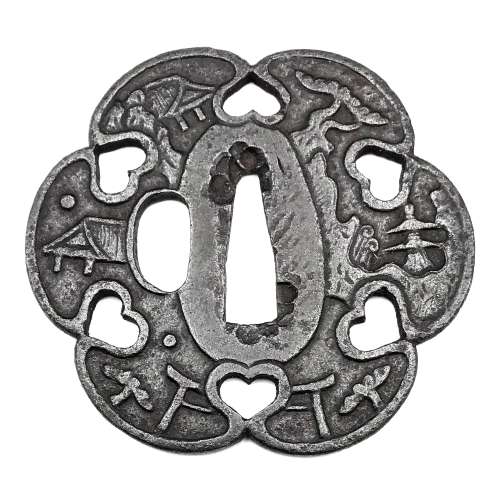 Iron tsuba of six-lobed (mutsu-mokkō-gata) form, with six wild boar's eye shape (inome) openings (sukashi). Hitsu-ana and the entire perimeter of tsuba have typical for this school raised rim. Lobes are decorated with landscape motifs in low relief carving (sukidashi-bori). On the obverse: A hut under a full moon, Shinto shrine gates (torii) with pines and a full moon, rocks, a large pine tree, and a temple (pagoda) surrounded by rocks and waves. On the reverse: waves, fishing boat, wild gees in flight under full moon, maple, hexagon (tortoiseshell, kikko) with a dot inside and a dot outside (inclusion/exclusion symbol), and chrysanthemum (the last two may be family crests, mon). Kamakura-bori school. Late Muromachi period (1514-1573). Height: 64.2 mm, width: 74.3 mm, Thickness at seppa-dai: 3.2 mm, at rim 2.6 mm. Weight: 62.8 g (light). NBTHK old green certificate №561: Tokubetsu Kicho - "Extraordinary Work". A look-a-like tsuba can be found at the Compton Collection, part II, pp. 14-15, №17, though his tsuba is more massive (80 x 84 x 4 mm).NBTHK paper says that the motif is Hakkei (八景), i.e. "Eight Views," so several interpretations are possible (the original Chinese ones, Omi Hakkei, etc.). However, most likely it is the 'Eight views of Omi' (近江八景 - 'Omi Hakkei'). Why the artist selected a 6-lobed form for depicting 8 views remains unclear, and thus we are in our right to raise the question whether the motif is indeed Hakkei. The term Omi hakkei (eight views of Omi) refers to painting or print sets which illustrate life on the shores of Lake Biwa in Omi (now Shiga Prefecture). The model for such paintings came from China, where, from the eleventh century onward, painters had produced eight views of the Hsiao and Hsiang lake areas of Hunan Province. The themes, which follow the original Chinese models, are: geese descending to land, returning fishing boats, clearing rain, a snow-covered evening landscape, the autumn moon, night rain, a temple bell at evening, and the glow of sunset. Japanese artists have also used the eight-theme approach for other parts of country - including cities - and applied it to subject matter other than landscapes. [Merrily Baird. Symbols of Japan. Thematic motifs in art and design. Rizzoli international publications, Inc., 2001, page 308-9]. Japan Encyclopedia by Louis Frédéric also mentions Omi Hakkei as "Eight landscapes of Omi", and states that this theme was often cited in poetry after 1500. It is likely that the tsuba in focus is designed under the influence of the theme popularity in the 16th century. The theme was effectively exploited by prominent ukiyo-e artists Suzuki Harunobu and Utagawa Hiroshige in the 18th and 19th century, respectively. These are the eight scenes of the theme (see Wikipedia):
Iron tsuba of six-lobed (mutsu-mokkō-gata) form, with six wild boar's eye shape (inome) openings (sukashi). Hitsu-ana and the entire perimeter of tsuba have typical for this school raised rim. Lobes are decorated with landscape motifs in low relief carving (sukidashi-bori). On the obverse: A hut under a full moon, Shinto shrine gates (torii) with pines and a full moon, rocks, a large pine tree, and a temple (pagoda) surrounded by rocks and waves. On the reverse: waves, fishing boat, wild gees in flight under full moon, maple, hexagon (tortoiseshell, kikko) with a dot inside and a dot outside (inclusion/exclusion symbol), and chrysanthemum (the last two may be family crests, mon). Kamakura-bori school. Late Muromachi period (1514-1573). Height: 64.2 mm, width: 74.3 mm, Thickness at seppa-dai: 3.2 mm, at rim 2.6 mm. Weight: 62.8 g (light). NBTHK old green certificate №561: Tokubetsu Kicho - "Extraordinary Work". A look-a-like tsuba can be found at the Compton Collection, part II, pp. 14-15, №17, though his tsuba is more massive (80 x 84 x 4 mm).NBTHK paper says that the motif is Hakkei (八景), i.e. "Eight Views," so several interpretations are possible (the original Chinese ones, Omi Hakkei, etc.). However, most likely it is the 'Eight views of Omi' (近江八景 - 'Omi Hakkei'). Why the artist selected a 6-lobed form for depicting 8 views remains unclear, and thus we are in our right to raise the question whether the motif is indeed Hakkei. The term Omi hakkei (eight views of Omi) refers to painting or print sets which illustrate life on the shores of Lake Biwa in Omi (now Shiga Prefecture). The model for such paintings came from China, where, from the eleventh century onward, painters had produced eight views of the Hsiao and Hsiang lake areas of Hunan Province. The themes, which follow the original Chinese models, are: geese descending to land, returning fishing boats, clearing rain, a snow-covered evening landscape, the autumn moon, night rain, a temple bell at evening, and the glow of sunset. Japanese artists have also used the eight-theme approach for other parts of country - including cities - and applied it to subject matter other than landscapes. [Merrily Baird. Symbols of Japan. Thematic motifs in art and design. Rizzoli international publications, Inc., 2001, page 308-9]. Japan Encyclopedia by Louis Frédéric also mentions Omi Hakkei as "Eight landscapes of Omi", and states that this theme was often cited in poetry after 1500. It is likely that the tsuba in focus is designed under the influence of the theme popularity in the 16th century. The theme was effectively exploited by prominent ukiyo-e artists Suzuki Harunobu and Utagawa Hiroshige in the 18th and 19th century, respectively. These are the eight scenes of the theme (see Wikipedia):
Compton Collection, part II, pp. 14-15, №17: Kamakura-bori tsuba, ca. 1450.
- Returning sails at Yabase (矢橋の帰帆) - Yabase. Yabase is an old harbour on the east side of the lake. Near the Tokaido, it was used for a shortcut to Otsu by boat.
- Evening glow at Seta (勢多(瀬田)の夕照) - The Chinese Bridge at Seta. The long bridge across the Seta was used by the Tokaido. In the background the "Fuji of Omi", the Mikamiyama. It is just above 400 m, but indeed well visible.
- Autumn moon at Ishiyama (石山の秋月) - Ishiyama Temple. The Ishiyamadera was located on a hillside next to the Seta River. It got his name form the strange rocks on which it is built, partly on supporting beams. A hut at the upper end of the site allows a view of the lake, and the moon.
- Clear breeze at Awazu (粟津の晴嵐) - Awazuhara. Awazu is well known for its pine wood, Awazu-ga-hara.
- Evening bell at Miidera (三井晩鐘) - Mii-dera. Miidera temple was built in the 8th century. Its famous bell is one of the "Three bells of Japan", the other two being those at Byoodo-in, Uji and at Jingoji, Kyoto.
- Evening rain at Karasaki (唐崎の夜雨) - Karasaki Shrine. Karasaki is a small cape with a single large pine tree, a hitsu-matsu.
- Wild geese returning home at Katata (堅田の落雁) - Ukimido. Alighting geese cannot be seen always, however the little temple near Katata in the square hōkyō-style, detached from the lakeside, connected by a bridge. The first part of the name uki is the same as in Ukiyo-e, meaning floating. Midō means temple.
- Evening snow at Hira (比良の暮雪) - Hira Mountains. The Hira mountains on the west side of the lake experience the hard winter, when the winter monsoon brings much snow from the continent.
-
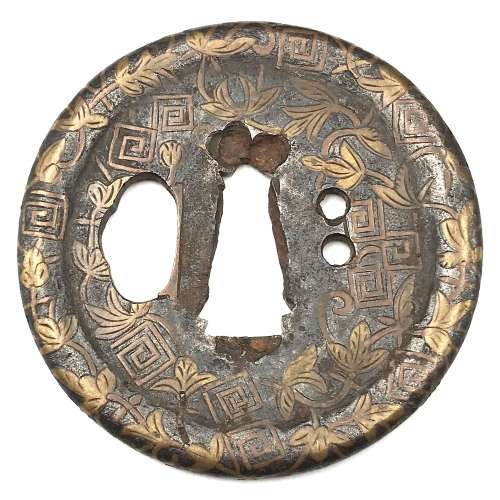
Iron tsuba of round form with dam-shaped rim (dote-mimi) pierced with hitsu-ana and two udenuki-ana (probably cut later on) decorated in flat inlay (hira-zōgan) with vines and symbols of thunder or lightning (possibly - family crest, mon). Hitsu-ana and nakago-ana with copper sekigane.
Ōnin or Heianjō school, or, possibly Kaga or Umetada school. Momoyama period or earlier (Muromachi), 16th century. Unsigned.Size: 64.5 x 63.8 x 2.2 (center), 4.2 (rim) mm.
Provenance: Lundgren Collection: [Japanese sword-fittings and metalwork in the Lundgren Collection. Published by Otsuka Kogeisha Co., Ltd., Tokyo 1992], №31; The Lundgren Collection of Japanese Swords, Sword Fittings and A Group of Miochin School Metalwork. Christie's Auction: Tuesday, 18 November 1997, London. Sales "GOTO-5881". Christie's, 1997, №2. Lundgren's description at Christie's: Heianjo tsuba. Unsigned. The circular plate decorated in brass hirazogan with flowers, plants and symbols of thunder, dote mimi and udenuki ana, late Muromachi period (16th century). Tokyo 1992 description: Sword guard with design of flowering plants and frets in inlay. Unsigned. Heianjo inlay school. 6.35 x 6.3 cm, thickness of rim 0.40 cm. Iron. Flat brass inlay. Muromachi-Momoyama Period, 16th century. Provenance: The Second John Harding. A somewhat look-a-like pieces can be found in various catalogues. The one in Naunton Collection, №172, is signed: Umetada of Yamashiro: "Iron, small, almost circular, with raised oval rim, inlaid all over with leaves and scrolls in brass hirazōgan." -
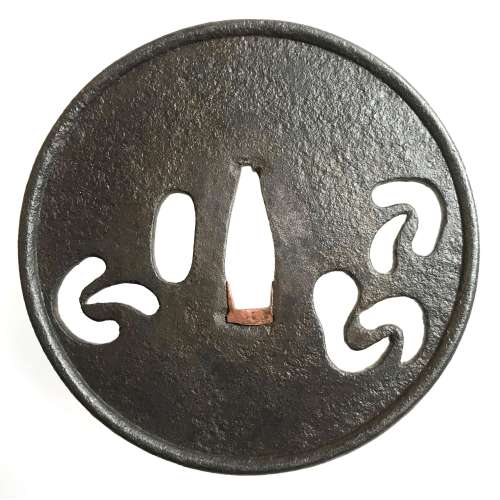 Iron tsuba of round form decorated with design of pine tree mushrooms (matsutake) in openwork (sukashi). Hitsu-ana of elongated oval form. Raised rim (mimi) with iron bones (tekkotsu). Copper sekigane. Size: 84.5 mm x 85.1 mm; thickness: 3.0 mm (center), 5.6 mm (rim). Mid Muromachi period, 15th century. The shape and width of the rim, as well as the shape of the hitsu-ana, argue for earlier Muromachi. Tsuba is slightly wider than high, that might suggest middle of Muromachi age. According to Robert Haynes, circa 1450-1500.
Iron tsuba of round form decorated with design of pine tree mushrooms (matsutake) in openwork (sukashi). Hitsu-ana of elongated oval form. Raised rim (mimi) with iron bones (tekkotsu). Copper sekigane. Size: 84.5 mm x 85.1 mm; thickness: 3.0 mm (center), 5.6 mm (rim). Mid Muromachi period, 15th century. The shape and width of the rim, as well as the shape of the hitsu-ana, argue for earlier Muromachi. Tsuba is slightly wider than high, that might suggest middle of Muromachi age. According to Robert Haynes, circa 1450-1500. -
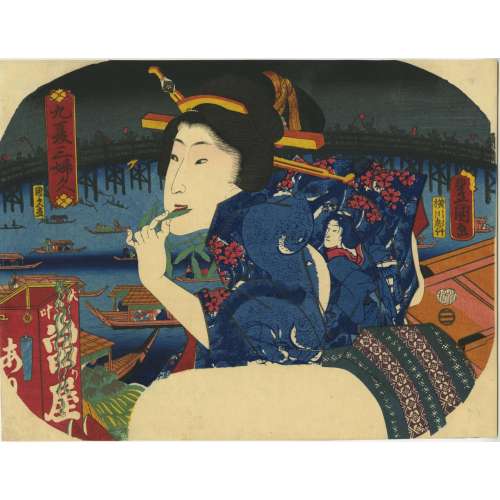 Untrimmed fan print (uchiwa-e), 231 x 300 mm. Title: A geisha eating edamame aboard the boat of the Atari-ya teahouse. Series: Three summer women [九夏三婦久] (Kyūka sanfuku). Artist: Utagawa Kunisada [歌川 国貞] a.k.a. Utagawa Toyokuni III [三代歌川豊国] (Japanese, 1786 – 1865). Artist: Utagawa Kunihisa II [歌川国久] a.k.a. Katsuda Hisatarō, Ichiunsai, Ritchōrō, Toyonobu, Yōryūsai, Yōsai] (Japanese, 1832 – 1981). Block cutter: Yokokawa Horitake [横川彫武] a.k.a. Yokokawa Takejiro [横川竹二郎] (Japanese, fl. 1860s). Publisher: Ibaya Senzaburō [伊場屋仙三郎] (Japanese, fl. C. 1845 – 1847) Combined date seal and kiwame censor seal: 1860 (Ansei 7 / Man'en 1 from 18/III). Signed: Toyokuni ga in toshidama cartouche, and Kunihisa ga. Provenance: The Collection of Paul F. Walter, Christie's, New York, 2017, lot 341; sol together with 5 other fan prints for $25,000. Before: Israel Goldman, Japanese Prints, Catalogue 9, 2003, no. 35. Ref: [LIB-1693.2018] The Collection of Paul Walter. — NY: Christie's, 2017, p. 363. Ref: Israel Goldman, Catalogue 2018, № 52: "Utagawa Kunisada (1786-1865) and Utagawa Kunihisa II (1832-1891) A Geisha Eating Edamame Aboard the Boat of the Atari-ya Teahouse. From the series Kyuka sanfuku (Three Summer Women). 1860. Fan print. 22.7 x 29.6 cm. Provenance: Israel Goldman, Japanese Prints, Catalogue 9, 2003, no. 35. The Collection of Paul F. Walter, Christies, New York, 201, lot 341. Fine impression, colour and condition. The title is a pun on “kyuka sanpuku” meaning the hottest point of the summer. The background view is by Kunisada’s pupil Kunihisa."
Untrimmed fan print (uchiwa-e), 231 x 300 mm. Title: A geisha eating edamame aboard the boat of the Atari-ya teahouse. Series: Three summer women [九夏三婦久] (Kyūka sanfuku). Artist: Utagawa Kunisada [歌川 国貞] a.k.a. Utagawa Toyokuni III [三代歌川豊国] (Japanese, 1786 – 1865). Artist: Utagawa Kunihisa II [歌川国久] a.k.a. Katsuda Hisatarō, Ichiunsai, Ritchōrō, Toyonobu, Yōryūsai, Yōsai] (Japanese, 1832 – 1981). Block cutter: Yokokawa Horitake [横川彫武] a.k.a. Yokokawa Takejiro [横川竹二郎] (Japanese, fl. 1860s). Publisher: Ibaya Senzaburō [伊場屋仙三郎] (Japanese, fl. C. 1845 – 1847) Combined date seal and kiwame censor seal: 1860 (Ansei 7 / Man'en 1 from 18/III). Signed: Toyokuni ga in toshidama cartouche, and Kunihisa ga. Provenance: The Collection of Paul F. Walter, Christie's, New York, 2017, lot 341; sol together with 5 other fan prints for $25,000. Before: Israel Goldman, Japanese Prints, Catalogue 9, 2003, no. 35. Ref: [LIB-1693.2018] The Collection of Paul Walter. — NY: Christie's, 2017, p. 363. Ref: Israel Goldman, Catalogue 2018, № 52: "Utagawa Kunisada (1786-1865) and Utagawa Kunihisa II (1832-1891) A Geisha Eating Edamame Aboard the Boat of the Atari-ya Teahouse. From the series Kyuka sanfuku (Three Summer Women). 1860. Fan print. 22.7 x 29.6 cm. Provenance: Israel Goldman, Japanese Prints, Catalogue 9, 2003, no. 35. The Collection of Paul F. Walter, Christies, New York, 201, lot 341. Fine impression, colour and condition. The title is a pun on “kyuka sanpuku” meaning the hottest point of the summer. The background view is by Kunisada’s pupil Kunihisa." -
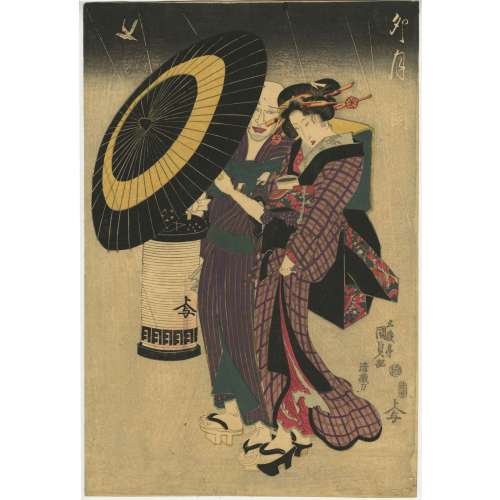 Utagawa Kunisada (Japanese: 歌川 国貞; also known as Utagawa Toyokuni III (三代歌川豊国); 1786 – 12 January 1865).
Utagawa Kunisada (Japanese: 歌川 国貞; also known as Utagawa Toyokuni III (三代歌川豊国); 1786 – 12 January 1865).A man with a shaved head (a monk), holding a paper lantern and an umbrella, walks with a young woman (a geisha) in the rain.
SIGNED: Gototei Kunisada ga [五渡亭国貞画]
Censor's seals: kiwame, futakata.
Blockcutter's mark: Seizô tô [改印:極、貳方]
MFA ACCESSION NUMBER 11.15150; MFA dating: about 1815–21 (Bunka 12–Bunsei 4);
Size: Vertical Ōban (382 x 260 mm). SOLD -
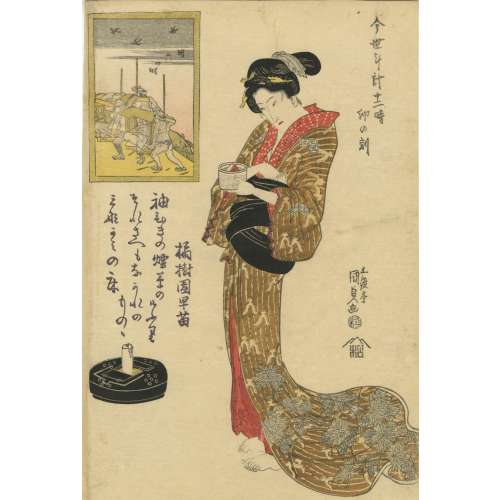 Artist: Utagawa Kunisada [歌川 国貞] a.k.a. Utagawa Toyokuni III [三代歌川豊国] (Japanese, 1786 – 1865). Publisher: Matsumura Tatsuemon [松村辰右衛門] (Japanese, fl. c. 1793 – 1832). Year: c. 1820–22 (Bunsei era). Signed: 五渡亭国貞画 – Gototei Kunisada ga. Censor's seal: kiwame 改印:極
Artist: Utagawa Kunisada [歌川 国貞] a.k.a. Utagawa Toyokuni III [三代歌川豊国] (Japanese, 1786 – 1865). Publisher: Matsumura Tatsuemon [松村辰右衛門] (Japanese, fl. c. 1793 – 1832). Year: c. 1820–22 (Bunsei era). Signed: 五渡亭国貞画 – Gototei Kunisada ga. Censor's seal: kiwame 改印:極

SVJP-0179-6.2014
The Hour of the Dragon, Fifth Hour of Day (Tatsu no koku, Hi no itsutsu toki), from the series Twelve Hours of a Modern Clock (Imayo tokei jūniji) 「今世時計十二時 辰ノ刻 日ノ五つ時」 MFA impression: 11.15315. 
SVJP-0179-1.2014
The Hour of the Rabbit, Sixth Hour of Day (U no koku, Ake muttsu toki), from the series Twelve Hours of a Modern Clock (Imayo tokei jūniji) 「今世時計十二時 卯ノ刻 明六つ時」. MFA impression: 11.15317 
SVJP-0179-2.2014
The Hour of the Monkey, Seventh Hour of Day (Saru no koku, Hi no nanatsu toki), from the series Twelve Hours of a Modern Clock (Imayo tokei jūniji) 「今様時計十二時 申ノ刻 日ノ七つ時」 MFA impression: 11.39692 
SVJP-0179-8.2014
The Hour of the Horse, Ninth Hour of Day (Uma no koku, Hi kokonotsu toki), from the series Twelve Hours of a Modern Clock (Imayo tokei jūniji) 「今世時計十二時 午ノ刻 日九つ時」. MFA impression: 11.15314 
SVJP-0179-4.2014
The Hour of the Boar, Fourth Hour of Night (I no koku, Yoru yottsu toki), from the series Twelve Hours of a Modern Clock (Imayo tokei jūniji) 「今世時計十二時 亥ノ刻 夜四つ時」. MFA impression: 11.15552 
SVJP-0179-3.2014
The Hour of the Tiger, Seventh Hour of Night (Tora no koku, Yoru nanatsu), from the series Twelve Hours of a Modern Clock (Imayo tokei jūniji) 「今世時計十二時 寅ノ刻 夜七つ」. MFA impression: 11.15313 Ref.: Izzard. Kunisada’s world [LIB-2970.2022]. 
SVJP-0179-5.2014
The Hour of the Ox, Eight Hour of Night (Ushi no koku, Yoru no yattsu toki), from the series Twelve Hours of a Modern Clock (Imayo tokei jūniji) 「今世時計十二時 丑ノ刻 夜ノ八つ時」. MFA impression: 11.26906 
SVJP-0179-7.2014
The Hour of the Rat, Ninth Hour of Night (Ne no koku, Yoru kokonotsu toki), from the series Twelve Hours of a Modern Clock (Imayo tokei jūniji) 「今世時計十二時 子ノ刻 夜九つ時」. MFA impression: 11.15312 -
 Iron tsuba of round form decorated with a ladle, pestle, mortar, and rice sickle in positive silhouette openwork (nikubori-ji-sukashi). Slightly rounded rim with iron bones (tekkotsu). Seppa-dai plugged with copper fittings (sekigane). Silver patina. The design resembles mochi-making utensils; mochi (rice cake) symbolizes longevity. Kanayama school, c. 1590 (Momoyama period). Note: unusually large size for a Kanayama tsuba: diameter 79.5 mm, thickness at seppa-dai: 5.5 mm, at rim: 6.0 mm. Concerning the design: While the ladle and pestle are clear, the mortar (under the seppa-dai), and the sickle (to the left) require certain imagination.
Iron tsuba of round form decorated with a ladle, pestle, mortar, and rice sickle in positive silhouette openwork (nikubori-ji-sukashi). Slightly rounded rim with iron bones (tekkotsu). Seppa-dai plugged with copper fittings (sekigane). Silver patina. The design resembles mochi-making utensils; mochi (rice cake) symbolizes longevity. Kanayama school, c. 1590 (Momoyama period). Note: unusually large size for a Kanayama tsuba: diameter 79.5 mm, thickness at seppa-dai: 5.5 mm, at rim: 6.0 mm. Concerning the design: While the ladle and pestle are clear, the mortar (under the seppa-dai), and the sickle (to the left) require certain imagination. -
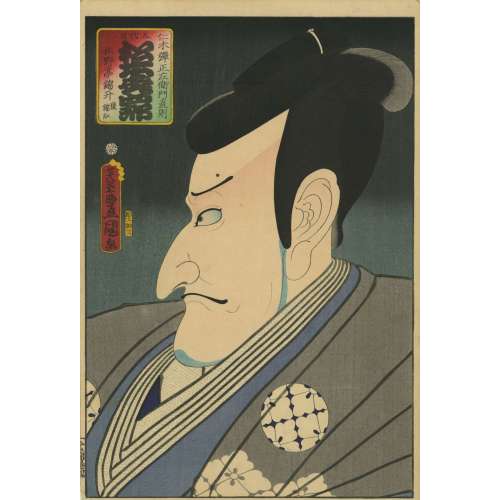 Kabuki actor: Matsumoto Kōshirō V [五代目松本幸四郎] (Japanese, 1764-1838); other names: Ichikawa Komazō III, Ichikawa Sumizō I. Role: Nikki Danjo (仁木弾正): "Evil retainer Nikki Danjo who plots to overthrow his lord in the play Precious incense and the bush clover of Sendai (Meiboku sendai hagi)" [R. Kruml]. Artist: Utagawa Kunisada [歌川 国貞] a.k.a. Utagawa Toyokuni III [三代歌川豊国] (Japanese, 1786 – 1865). Block cutter: Horikō (Kiyomizu) Ryūzō [彫工 柳三]. Publisher: Ebisuya Shoshichi [恵比寿屋庄七], Kinshōdō (Japanese, fl. c. 1846 – 1883). Year: 1863 (Bunkyū 3), 7th month. Size: Vertical ōban, hōsho paper. Signed: Nanajuhassai (aged seventy-eight) Toyokuni ga within toshidama cartouche. Censor’s seal: date-aratame. This print is from a series of portraits that Kunisada undertook very late in life and has been named Kinshodo-ban yakusha okubi-e (Kinshodo’s Large-Head Actor Portraits) in reference to the publisher, Ebisuya Shochochi of Kinshodo. The series depicted great actors in their famous roles from the past and present. Ref.: (1) [LIB-1212.2017] Robert Schaap. Kunisada: Imaging, drama and beauty. — Leiden: Hotei Publishing, 2016, p. 118 and 167 (№ 42):
Kabuki actor: Matsumoto Kōshirō V [五代目松本幸四郎] (Japanese, 1764-1838); other names: Ichikawa Komazō III, Ichikawa Sumizō I. Role: Nikki Danjo (仁木弾正): "Evil retainer Nikki Danjo who plots to overthrow his lord in the play Precious incense and the bush clover of Sendai (Meiboku sendai hagi)" [R. Kruml]. Artist: Utagawa Kunisada [歌川 国貞] a.k.a. Utagawa Toyokuni III [三代歌川豊国] (Japanese, 1786 – 1865). Block cutter: Horikō (Kiyomizu) Ryūzō [彫工 柳三]. Publisher: Ebisuya Shoshichi [恵比寿屋庄七], Kinshōdō (Japanese, fl. c. 1846 – 1883). Year: 1863 (Bunkyū 3), 7th month. Size: Vertical ōban, hōsho paper. Signed: Nanajuhassai (aged seventy-eight) Toyokuni ga within toshidama cartouche. Censor’s seal: date-aratame. This print is from a series of portraits that Kunisada undertook very late in life and has been named Kinshodo-ban yakusha okubi-e (Kinshodo’s Large-Head Actor Portraits) in reference to the publisher, Ebisuya Shochochi of Kinshodo. The series depicted great actors in their famous roles from the past and present. Ref.: (1) [LIB-1212.2017] Robert Schaap. Kunisada: Imaging, drama and beauty. — Leiden: Hotei Publishing, 2016, p. 118 and 167 (№ 42): Ref.: (1) [LIB-1197.2016] Arendie and Henk Herwig. Heroes of the kabuki stage: an introduction to kabuki with retellings of famous plays, illustrated by woodblock prints. — Amsterdam: Hotei Publishing, 2004; pp. 243-249.
Ref.: (1) [LIB-1197.2016] Arendie and Henk Herwig. Heroes of the kabuki stage: an introduction to kabuki with retellings of famous plays, illustrated by woodblock prints. — Amsterdam: Hotei Publishing, 2004; pp. 243-249.


-
 Iron tsuba of the round form (maru gata) with a grey patina pierced with the design of slanting rays of light (Jesuit’s IHS symbol) and a pair of ginger symbols [茗荷] (myōga) at top and bottom, in positive silhouette (ji-sukashi). This design is often called “tokei” [時計] or “clock gear”. Rounded rim, large hitsu-ana, copper fittings (sekigane). Unsigned, unpapered. Owari school. Early Edo period, early 17th century.
Iron tsuba of the round form (maru gata) with a grey patina pierced with the design of slanting rays of light (Jesuit’s IHS symbol) and a pair of ginger symbols [茗荷] (myōga) at top and bottom, in positive silhouette (ji-sukashi). This design is often called “tokei” [時計] or “clock gear”. Rounded rim, large hitsu-ana, copper fittings (sekigane). Unsigned, unpapered. Owari school. Early Edo period, early 17th century.Size: H 71.9 x W 71.1 x Th (centre) 5.5 cm.
For information regarding this type of tsuba see the article 'Kirishitan Ikenie Tsuba by Fred Geyer at Kokusai Tosogu Kai; The 2nd International Convention & Exhibition, October 18-23, 2006, pp. 84-91. 
IHS emblem of the Jesuits

茗荷 Myoga or Japanese ginger
-
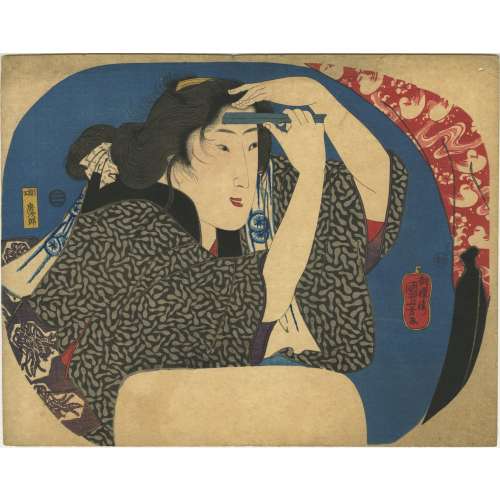 Artist: Utagawa Kuniyoshi [歌川 國芳] (Japanese, 1798 – 1861). Publisher: Ibaya Senzaburō [伊場屋仙三郎] (Japanese, fl. C. 1845 – 1847), seal: San [三] (Marks 11-001 | 127c). Carver: Matsushima Fusajirō [松嶋房次郎] (Japanese, fl. 1843 – 1850); seal [彫工房次郎] – Hori kō Fusajirō (Gordon Friese № 136) Signed: Chōōrō Kuniyoshi ga [朝櫻楼国芳画] in a red double gourd-shaped cartouche. Nanushi censor seal: Tanaka [田中]; V/1844 or II/1845. Media: Fan print (uchiwa-e, 団扇絵), 238 x 304 mm. Reference: Kuniyoshi Project. Series mentioned in Robert Schaap. Heroes and ghosts: Japanese prints by Kuniyoshi, 1797-1861.— Leiden: Hotei Publishing, 1998; p. 122 [LIB-1030.2016].
Artist: Utagawa Kuniyoshi [歌川 國芳] (Japanese, 1798 – 1861). Publisher: Ibaya Senzaburō [伊場屋仙三郎] (Japanese, fl. C. 1845 – 1847), seal: San [三] (Marks 11-001 | 127c). Carver: Matsushima Fusajirō [松嶋房次郎] (Japanese, fl. 1843 – 1850); seal [彫工房次郎] – Hori kō Fusajirō (Gordon Friese № 136) Signed: Chōōrō Kuniyoshi ga [朝櫻楼国芳画] in a red double gourd-shaped cartouche. Nanushi censor seal: Tanaka [田中]; V/1844 or II/1845. Media: Fan print (uchiwa-e, 団扇絵), 238 x 304 mm. Reference: Kuniyoshi Project. Series mentioned in Robert Schaap. Heroes and ghosts: Japanese prints by Kuniyoshi, 1797-1861.— Leiden: Hotei Publishing, 1998; p. 122 [LIB-1030.2016].
-
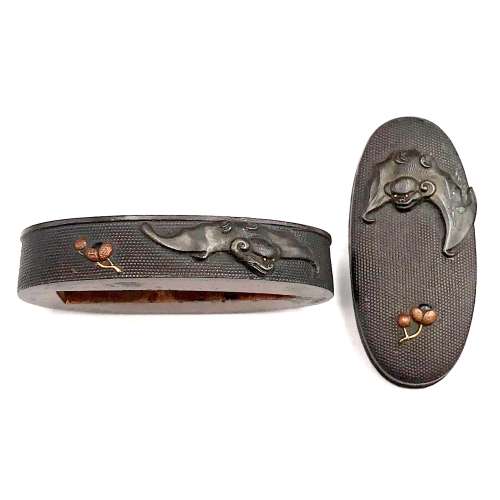
Fuchi-kashira made of shakudō carved and inlaid with gold and red copper with the design of a bat and a fruit (persimmon?). Nanako surface.
Fuchi: 37 x 19 x 7 mm. Kashira: 34 x 16 x 5 mm. Main material: shakudō. Other metals: gold and copper. Surface treatment: nanako-ji. -
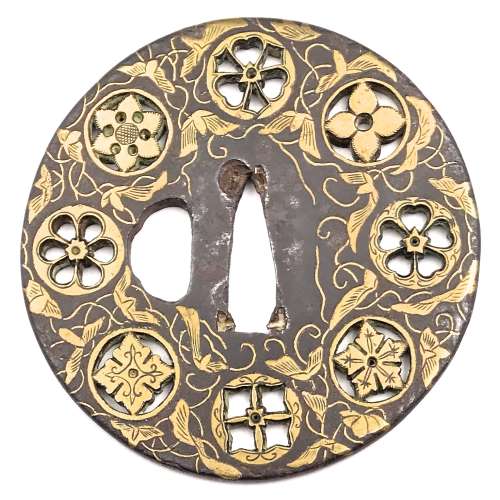 Iron tsuba of round form decorated with eight circular emblems of flowers and/or family crests (mon) made of cast brass, pierced and chiseled in kebori, as well as with flat brass inlay (hira-zōgan) of vines, leaves, and flowers all over the plate. Yoshirō school (Kaga-Yoshirō). The Momoyama or early Edo period, 17th century. Size: diameter 80 mm, thickness at seppa-dai 3,6 mm. Symbols: [12:00 o'clock] - Wood sorrel (katabami) and swords ; [9:00] - Cherry blossom (sakura); [7:30] - Bellflower (kikyō), kamon of Toki clan; [3:00] - possibly, a six-petal Chrysanthemum (kiku) or a Passion flower (tessen); [1:30] - Hemp (asanoha). The symbols at 6:00, 10:30, and 4:30 o'clock seem to be geometrical patterns of auspicious meaning: a cross in a square, a four pointing star, and a diamond, respectively. Alternatively, we may look at this piece as purely decorative, with patterns at 12:00, 3:00, 6:00, and 9:00 o'clock in negative openwork (in-sukashi), and at 1:30, 4:40, 7:20, and 10:30 o'clock - in positive openwork (ji-sukashi, or yō-sukashi). Markus Sesko in his Handbook of sword fittings related terms [Herstellung und Verlag: Books on Demand GmbH, Norderstedt, 2011] discriminates this type of openwork in a separate class: Ranma-sukashi: "This term is applied to circular sukashi with family crests to their inside, which are arranged running along the rim area. The description goes back to the opened boards (ranma) between the sliding doors and the ceiling of Japanese rooms. Ranma-sukashi are mostly seen on old Heianjō- or Yoshirō-zōgan-tsuba but also on works of Hayashi Matashichi" [page 30].
Iron tsuba of round form decorated with eight circular emblems of flowers and/or family crests (mon) made of cast brass, pierced and chiseled in kebori, as well as with flat brass inlay (hira-zōgan) of vines, leaves, and flowers all over the plate. Yoshirō school (Kaga-Yoshirō). The Momoyama or early Edo period, 17th century. Size: diameter 80 mm, thickness at seppa-dai 3,6 mm. Symbols: [12:00 o'clock] - Wood sorrel (katabami) and swords ; [9:00] - Cherry blossom (sakura); [7:30] - Bellflower (kikyō), kamon of Toki clan; [3:00] - possibly, a six-petal Chrysanthemum (kiku) or a Passion flower (tessen); [1:30] - Hemp (asanoha). The symbols at 6:00, 10:30, and 4:30 o'clock seem to be geometrical patterns of auspicious meaning: a cross in a square, a four pointing star, and a diamond, respectively. Alternatively, we may look at this piece as purely decorative, with patterns at 12:00, 3:00, 6:00, and 9:00 o'clock in negative openwork (in-sukashi), and at 1:30, 4:40, 7:20, and 10:30 o'clock - in positive openwork (ji-sukashi, or yō-sukashi). Markus Sesko in his Handbook of sword fittings related terms [Herstellung und Verlag: Books on Demand GmbH, Norderstedt, 2011] discriminates this type of openwork in a separate class: Ranma-sukashi: "This term is applied to circular sukashi with family crests to their inside, which are arranged running along the rim area. The description goes back to the opened boards (ranma) between the sliding doors and the ceiling of Japanese rooms. Ranma-sukashi are mostly seen on old Heianjō- or Yoshirō-zōgan-tsuba but also on works of Hayashi Matashichi" [page 30]. -
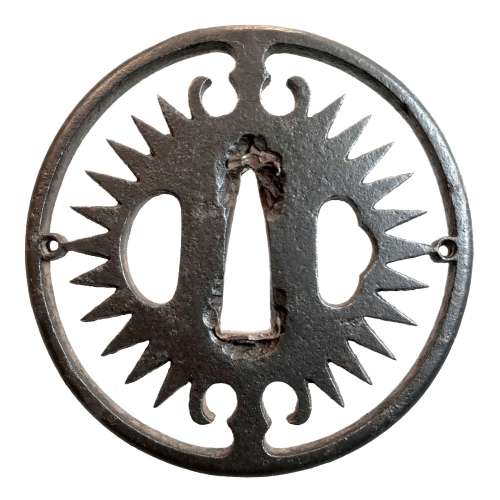 Iron tsuba of round form with design of slanting rays of light (shakoh) or clock gear (tokei) in openwork (sukashi). Commonly considered a Christian / Jesuit motif. Copper sekigane. According to seller, Owari School. Haynes writes that most tsuba of this design are Owari (Tsuba. Aesthetic Study). Unsigned. Edo period. According to F. Geyer, diamond-shaped vertical posts and long rays suggest that this tsuba was probably made between 1605 and 1630.
Iron tsuba of round form with design of slanting rays of light (shakoh) or clock gear (tokei) in openwork (sukashi). Commonly considered a Christian / Jesuit motif. Copper sekigane. According to seller, Owari School. Haynes writes that most tsuba of this design are Owari (Tsuba. Aesthetic Study). Unsigned. Edo period. According to F. Geyer, diamond-shaped vertical posts and long rays suggest that this tsuba was probably made between 1605 and 1630.Size: 76.9 x 76.0 x 5.4 mm
For information regarding shakoh tsuba see article 'Kirishitan Ikenie Tsuba by Fred Geyer at Kokusai Tosogu Kai; The 2nd International Convention & Exhibition, October 18-23, 2006, pp. 84-91. -
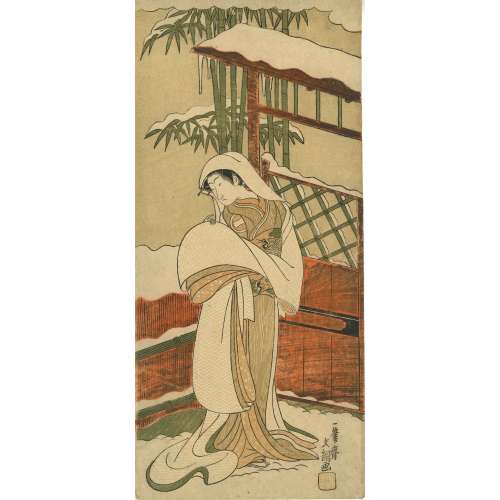 Ippitsusai Bunchō [一筆斎文調] (Japanese, 1725 – 1794). Size: Vertical Hosoban. As the Library of Congress put it: "Print shows the actor Ichikawa Monnosuke II, full-length portrait, facing left, standing on the snow-covered veranda". Actor: Ichikawa Monnosuke II [市川門之助] (Japanese, 1743/56 – 1794); other names: Ichikawa Benzō I, Takinaka Hidematsu II, Takinaka Tsuruzō. According to Heroes of the Kabuki Stage [LIB-1197.2016] Ichikawa Monnosuke II was active from 11/1770 to 10/1794. Play: Chūshingura [忠臣蔵] (The Treasury of Loyal Retainers), played at Nakamuraza in the 4the month of Meiwa 8 (1771). The actor played in a variety of roles and performances and was the subject of multiple woodblock prints by many famous ukiyo-e artists, including Bunchō, Katukawa Shunkō, Katukawa Shunshō, Katsukawa Shun'ei, Tōshūsai Sharaku, and many others. Ref: Vever (1976), vol. 1, № 242, p. 227.
Ippitsusai Bunchō [一筆斎文調] (Japanese, 1725 – 1794). Size: Vertical Hosoban. As the Library of Congress put it: "Print shows the actor Ichikawa Monnosuke II, full-length portrait, facing left, standing on the snow-covered veranda". Actor: Ichikawa Monnosuke II [市川門之助] (Japanese, 1743/56 – 1794); other names: Ichikawa Benzō I, Takinaka Hidematsu II, Takinaka Tsuruzō. According to Heroes of the Kabuki Stage [LIB-1197.2016] Ichikawa Monnosuke II was active from 11/1770 to 10/1794. Play: Chūshingura [忠臣蔵] (The Treasury of Loyal Retainers), played at Nakamuraza in the 4the month of Meiwa 8 (1771). The actor played in a variety of roles and performances and was the subject of multiple woodblock prints by many famous ukiyo-e artists, including Bunchō, Katukawa Shunkō, Katukawa Shunshō, Katsukawa Shun'ei, Tōshūsai Sharaku, and many others. Ref: Vever (1976), vol. 1, № 242, p. 227.
Katsukawa Shun'ei. The Actor Ichikawa Monnosuke II in an Aragoto Role. LACME.

Actor Ichikawa Monnosuke II as Date no Yosaku Artist Tôshûsai Sharaku (Japanese, active 1794–1795), Publisher Tsutaya Jûzaburô (Kôshodô) (Japanese) 1794 (Kansei 6), 5th month. MFA.

Ippitsusai Bunchô. Actor Ichikawa Monnosuke II as Tsunewakamaru. Play: Iro Moyô Aoyagi Soga Theater: Nakamura. MFA.
-
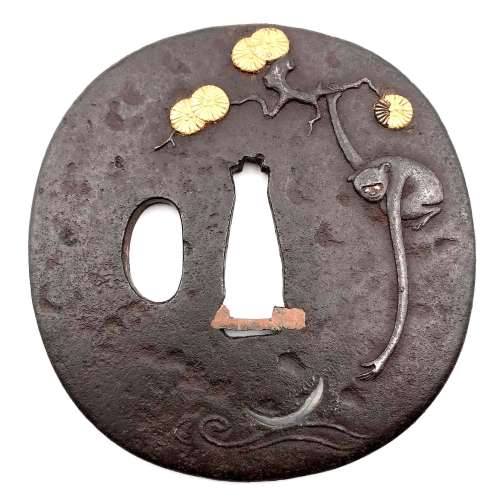 [SOLD]
[SOLD]Iron tsuba of slightly elongated round form carved and inlaid in gold and shibuichi with a long-armed monkey hanging from a pine tree branch reaching for the reflection of a crescent moon in the stream. A pine tree carved with details inlaid in gold on the reverse. The design seems to be inspired by Kaneie work (Compton III, p. 10, №6a; Tsuba no bi, 1947, p. 33, №56).
Dimensions: 76.8 x 74.2 x 3.6 mm. Mid-Edo period. Unsigned.
Compton III, p. 10, №6a

Tsuba no bi, 1947, p. 33, №56.
-
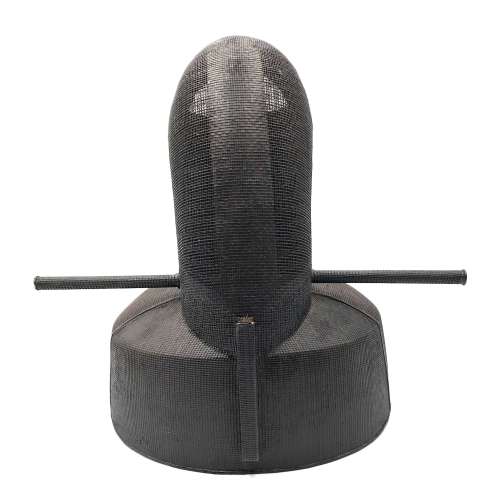 Kanmuri - a classic court cap, made of lacquered wood and paper. It is traditionally made by creating a skeleton, or harinuki, of paper on a wooden form. The outside of the hari-nuki is lacquered so as to keep its shape, and then the body of ra silk is layed on top. The entire thing is lacquered stiff.
Kanmuri - a classic court cap, made of lacquered wood and paper. It is traditionally made by creating a skeleton, or harinuki, of paper on a wooden form. The outside of the hari-nuki is lacquered so as to keep its shape, and then the body of ra silk is layed on top. The entire thing is lacquered stiff.Size: Height:20cm; Width: 21cm; Depth: 20cm.
Probably Taishō period (1912-1926), or later. Certain information is provided at http://www.sengokudaimyo.com/garb/garb.html In a wooden box without inscriptions. -
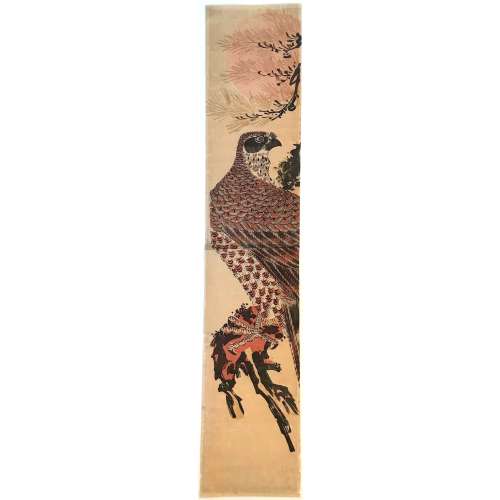 The print lacks signature. It is attributed by some to Suzuki Harunobu and by the others to Isoda Koryūsai.
The print lacks signature. It is attributed by some to Suzuki Harunobu and by the others to Isoda Koryūsai.Attributed to Koryūsai: Pins #517/p.209, c. 1775 [AIC II: Clarence Buckingham Collection, 1925.2772], Ukiyo-e Taisei IV; Vignier & Inada, 1911; Ritsumeikan University Z0165-239.
Attributed to Harunobu: Pins #239/p.132.; BM 1906,1220,0.85;


